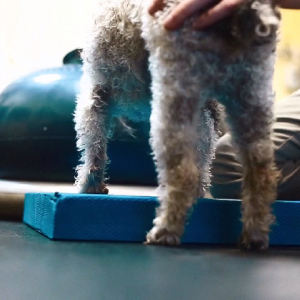 Effective Exercises After IVDD Treatment
Effective Exercises After IVDD Treatment
Intervertebral disc disease (IVDD) is a very common problem neurological, surgery and physical rehabilitation practitioners see in practice. Even more so is the patient with a lesion at or around the T/L junction (mid-back). This can affect many breeds but we tend to see more Dachshunds, Poodles and Cocker Spaniels more than any others.
Some of the more common symptoms seen in these dogs are weakness, ataxia (incoordination), and proprioception deficits (scuffing toes and knuckling the foot under while walking) Another common symptom we see that directly affects function is extensor rigidity which means that the legs will tend to be held stiff and straight. This is common when we have problems in parts of the spinal cord in the neck to middle back area (upper motor neuron).
While increased extensor muscle tone can make it harder for a patient to flex the limbs, it can sometimes help us exercise patients a little easier because it better allows for weight-bearing. This allows us to better target desired functions like standing and walking.
The video below follows a MedVet Medical & Cancer Centers patient, Bogey, through about 5 weeks of therapy.
Bogey presented to MedVet Mandeville with no pain sensation in his rear limbs, was brought to surgery and regained sensation within about a week, though was still unable to walk or stand.
Physical rehabilitation started approximately 2 weeks post op, and included underwater treadmill and targeted sit to stand exercises using positive reinforcement training techniques on FitPAWS® Canine Conditioning Equipment. As I have written in the past, the SAID Principle helps guide me in picking effective exercises for patients and athletes, and these two exercises fit very well into this concept. Bogey’s short term goals were to be able to stand and walk, and that’s precisely what we worked on in therapy.
Underwater treadmill exercise allowed Bogey to walk without falling, the buoyancy of water aided in stabilizing his gait and supported the weight that he could not. This also set Bogey up to succeed while practicing walking as perfectly as possible.
Sit to stand exercises targeted the other functional goal for Bogey. In my experience, this really helps hone in on teaching a patient how to eccentrically contract their quadriceps again. When I train a patient I only use positive reinforcement. I see no real benefit in forcing a dog to do much of anything, they never learn that way, and when healing animals or people recover from neurologic disease, I find it essential in their understanding of their own movements.
Another thing I am very particular about is when I reward a patient during this activity, as well as how much of a reward I give.
- My general rules are:
- Reward for every action
- Reward for attention, especially when starting a new session
- Reward for standing on the FitPAWS® Balance Pad (front feet)
The most important time to reward is when they learn to release their quadriceps and get into a sit. Sometimes I let the patient nibble on the reward until they finish an action, then jackpot them for the action I was looking for.
Bogey continues to improve and is now “more active, fit and walks longer than he did before his injury,” says his owners.
For more about “lure reward” training check out my tutorial here:
by Rosanne Krupka Peters, DVM, CVA, DACVIM (Neurology)
and Robert J Porter, Certified Canine Rehabilitation Practitioner
 Robert Porter LMT, CCRP is the physical rehabilitation treatment supervisor at MedVet Medical & Cancer Center (Mandeville location). He was one of the first 30 people in the United States to become a Certified Canine Rehabilitation Practitioner from the University of Tennessee and has been working, full time, in the field of veterinary physical rehabilitation since 2000. Robby has a strong interest in positive training approaches to specific targeted exercise in canine sports medicine. Having a vast knowledge of canine pathology and years of experience working along side veterinary surgeons has given him a unique and creative perspective on approaches to therapeutic and conditioning exercises.
Robert Porter LMT, CCRP is the physical rehabilitation treatment supervisor at MedVet Medical & Cancer Center (Mandeville location). He was one of the first 30 people in the United States to become a Certified Canine Rehabilitation Practitioner from the University of Tennessee and has been working, full time, in the field of veterinary physical rehabilitation since 2000. Robby has a strong interest in positive training approaches to specific targeted exercise in canine sports medicine. Having a vast knowledge of canine pathology and years of experience working along side veterinary surgeons has given him a unique and creative perspective on approaches to therapeutic and conditioning exercises.
Robert J Porter, Director of Treatment
MedVet Mandeville
Physical Rehabilitation Department,
www.medvetforpets.com
www.facebook.com/medvetforpets
www.facebook.com/medvetforpets.mandeville
